Website www.jeanharlow.com Height 1.55 m Years active 1928–37 | Occupation Actress Role Film actress Education Ferry Hall School Name Jean Harlow | |
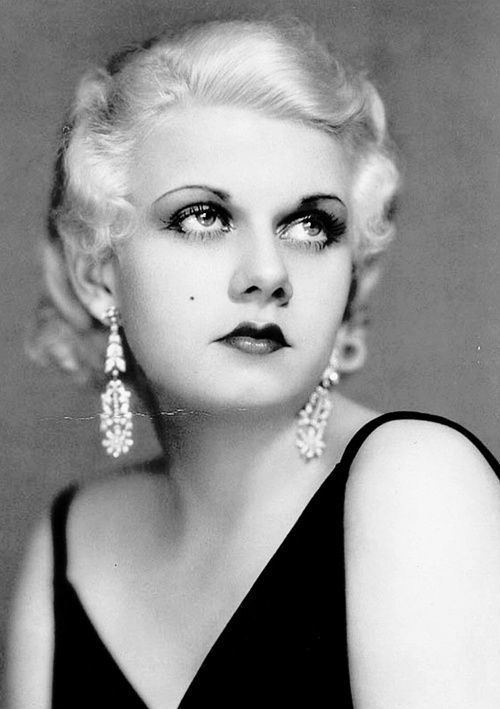 | ||
Full Name Harlean Harlow Carpenter Born March 3, 1911 ( 1911-03-03 ) Kansas City, Missouri, U.S. Resting place Forest Lawn Memorial Park, Glendale, California, U.S. Died June 7, 1937, Los Angeles, California, United States Spouse Harold Rosson (m. 1933–1935), Paul Bern (m. 1932–1932), Charles McGrew (m. 1927–1929) Movies Red Dust, Dinner at Eight, Hell's Angels, Libeled Lady, Saratoga Similar People Carole Lombard, William Powell, Clark Gable, Lana Turner, Joan Crawford | ||
Cause of death cerebral edema, uremia Full name Harlean Harlow Carpenter | ||
Jean harlow jean harlow biography featuring interviews with those who knew her best
Jean Harlow (born Harlean Harlow Carpenter; March 3, 1911 – June 7, 1937) was an American film actress and sex symbol of the 1930s.
Contents
- Jean harlow jean harlow biography featuring interviews with those who knew her best
- Two tragic blondes marilyn monroe and jean harlow
- Childhood
- 19271929 Marriage and beginnings
- 19291932 Breakthrough
- 19321936 MGM stardom
- Death
- Novel
- Film portrayals
- Legacy
- Filmography
- References
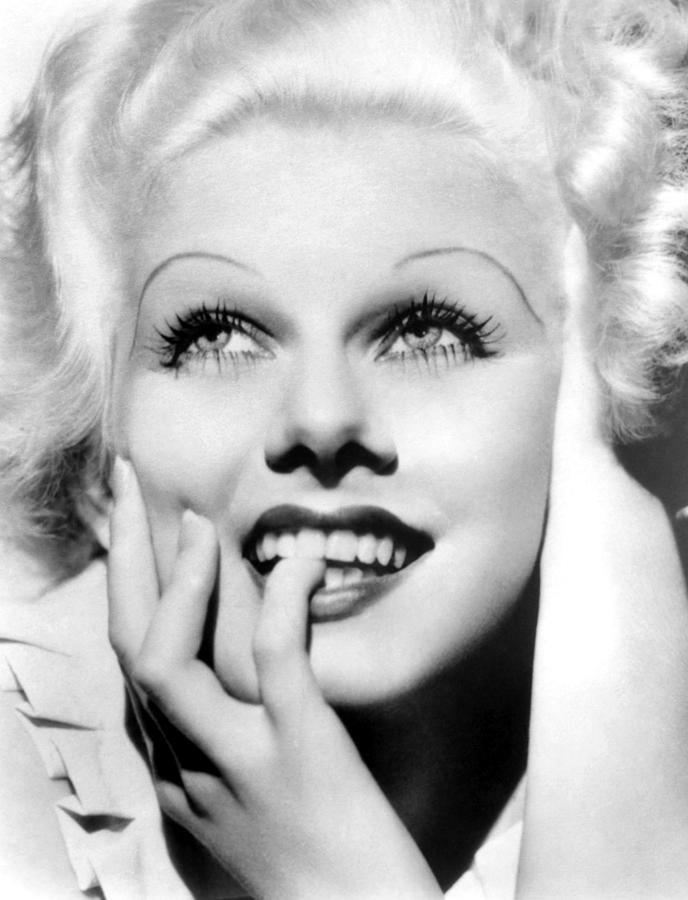
Harlow was signed by director Howard Hughes, and her first major appearance was in Hell's Angels (1930), followed by a series of critically unsuccessful films before she signed with Metro-Goldwyn-Mayer in 1932. Harlow became a leading lady for MGM, starring in a string of hit films including Red Dust (1932), Dinner at Eight (1933), Reckless (1935), and Suzy (1936). Harlow's popularity rivaled and soon surpassed that of her MGM colleagues Joan Crawford and Norma Shearer. She had become one of the biggest movie stars in the world by the late 1930s, often nicknamed the "Blond Bombshell" and the "Platinum Blonde"; she was also popular for her "Laughing Vamp" movie persona.
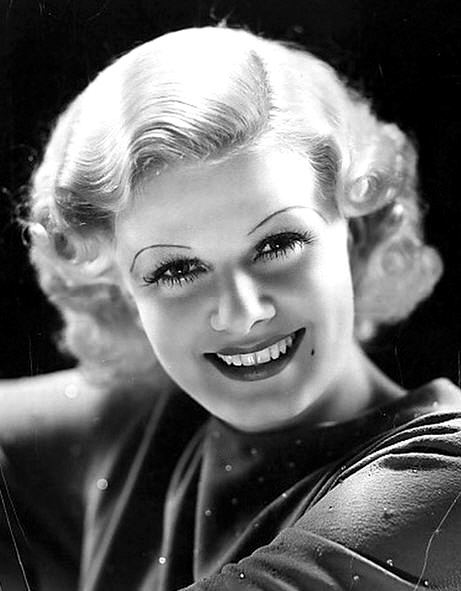
Harlow died at age 26 during the 1937 filming of Saratoga. The film was completed using body doubles and released a little over a month after Harlow's death. The American Film Institute ranked her as the 22nd greatest female star of classic Hollywood cinema.
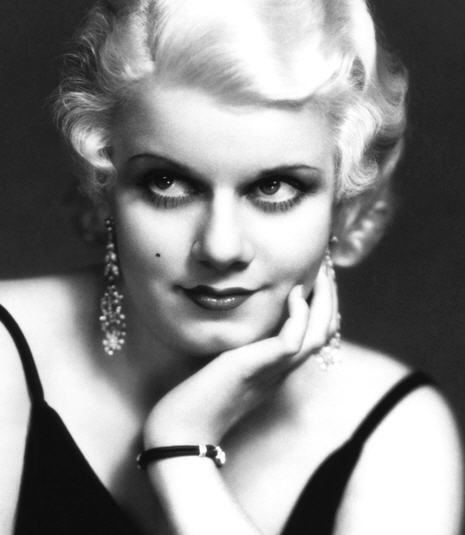
Two tragic blondes marilyn monroe and jean harlow
Childhood

Harlow was born Harlean Harlow Carpenter in Kansas City, Missouri. The name is sometimes incorrectly spelled Carpentier, following later studio press releases. Her father, Mont Clair (or Montclair) Carpenter (1877–1974), son of Abraham L. Carpenter and Dianna (née Beal), was a dentist from a working-class background who attended dental school in Kansas City. Her mother, Jean Poe Carpenter (née Harlow; 1891–1958), was the daughter of a wealthy real estate broker, Skip Harlow, and his wife, Ella Harlow (née Williams). The marriage was arranged by Jean's father for their underage daughter in 1908. Jean was resentful, and became very unhappy in the marriage. The couple lived in Kansas City in a house owned by Jean's father.
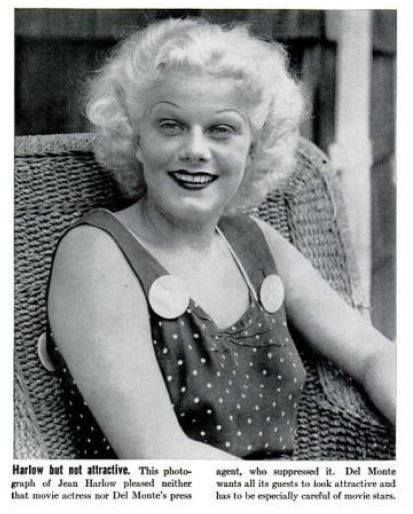
Harlean was nicknamed "The Baby", a name that would stick with her for the rest of her life. She did not learn that her name was actually "Harlean" until the age of five, when she began to attend Miss Barstow's Finishing School for Girls in Kansas City. Harlean and "Mother Jean", as she became known when Harlean became a film star, remained very close. Harlean's mother was extremely protective and coddling, reportedly instilling a sense that her daughter owed everything she had to her. "She was always all mine", she said of her daughter.
When Harlean was at school, her mother filed for a divorce that was finalized uncontested on September 29, 1922. She was granted sole custody of Harlean, who loved the father who would survive her by thirty-seven years. However, Harlean would rarely see him again. Mother Jean moved with Harlean to Hollywood in 1923 with hopes of becoming an actress, but was too old at 34 to begin a film career. Young Harlean attended the Hollywood School for Girls and met Douglas Fairbanks, Jr., Joel McCrea, and Irene Mayer Selznick. Harlean dropped out of school at age 14 in the spring of 1925. Finances dwindling, she and her mother moved back to Kansas City after Skip Harlow issued an ultimatum that he would disinherit Jean if she did not return. Several weeks later, Skip sent his granddaughter to a summer camp, Camp Cha-Ton-Ka, in Michigamme, Michigan, where she became ill with scarlet fever. Her mother traveled to Michigan to care for her, rowing herself across the lake to the camp, but was told she could not see her daughter.
1927–1929: Marriage and beginnings
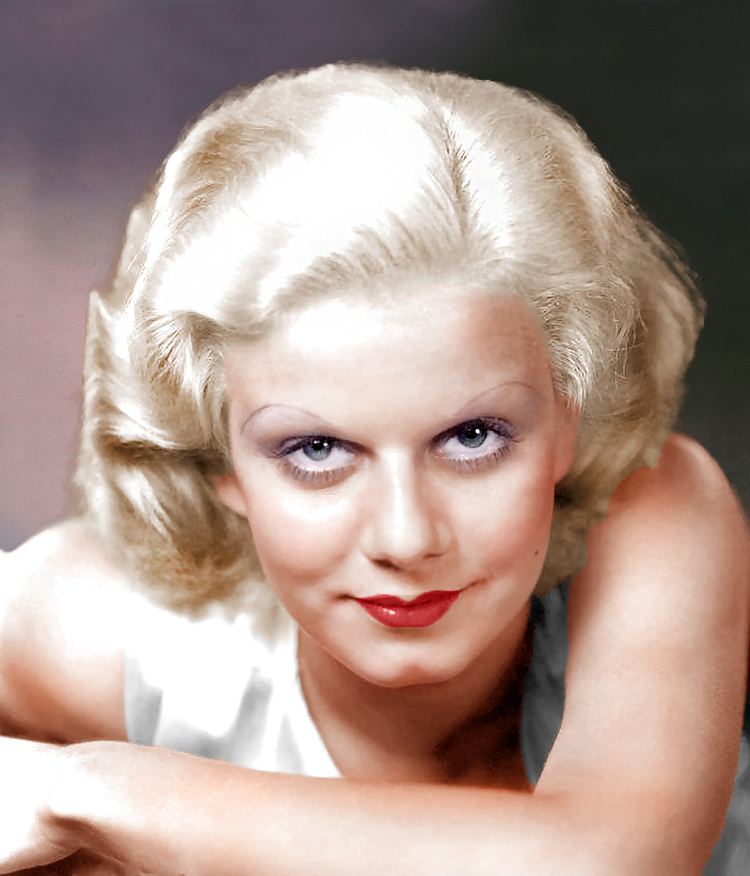
Harlow next attended the Ferry Hall School (now Lake Forest Academy) in Lake Forest, Illinois. Her mother had an ulterior motive for Harlean's attendance there, as it was close to the Chicago home of her boyfriend, Marino Bello. Each freshman was paired with a "big sister" from the senior class, and Harlean's big sister introduced her to 19-year-old Charles "Chuck" Fremont McGrew, heir to a large fortune, in the fall of 1926. Soon the two began to date, and then married. On January 18, 1927, Jean Carpenter also married Bello; Harlean was not present.

Shortly after the wedding, the couple left Chicago and moved to Beverly Hills. McGrew turned 21 two months after the marriage and received part of his large inheritance. The couple moved to Los Angeles in 1928, settling into a home in Beverly Hills, where Harlean thrived as a wealthy socialite. McGrew hoped to distance Harlean from her mother with the move. Neither McGrew nor Harlean worked, and both, especially McGrew, were thought to drink heavily. The couple divorced in 1929.
In Los Angeles, Harlean befriended Rosalie Roy, a young aspiring actress. Lacking a car, Roy asked Harlean to drive her to Fox Studios for an appointment. Reputedly, Harlean was noticed and approached by Fox executives while waiting for her friend, but stated that she was not interested. Nevertheless, she was given dictated letters of introduction to Central Casting. A few days later, Rosalie Roy bet Harlean that she did not have the nerve to go and audition. Unwilling to lose a wager and pressed by her enthusiastic mother, Harlean drove to Central Casting and signed in under her mother's maiden name, Jean Harlow.
After several calls from Central Casting and a number of rejected job offers, Harlean was pressed into accepting work by her mother, now back in Los Angeles. She appeared in her first film, Honor Bound, as an unbilled extra for $7 a day. This led to small parts in feature films such as Moran of the Marines (1928), This Thing Called Love (1929), Close Harmony (1929), and The Love Parade (1929), among others. In December 1928, she signed a five-year contract with Hal Roach Studios for $100 per week. She had a co-starring role in Laurel and Hardy's short Double Whoopee in 1929, and went on to appear in two more of their films: Liberty and Bacon Grabbers (both 1929).
In March 1929, however, she parted with Roach, who tore up her contract after Harlow told him, "It's breaking up my marriage, what can I do?" In June 1929, Harlow separated from her husband and moved in with her mother and Bello. After her separation from McGrew, Harlow worked as an extra in several movies. She landed her first speaking role in 1929's The Saturday Night Kid, starring Clara Bow.
1929–1932: Breakthrough
In late 1929, she was spotted by James Hall, an actor filming Howard Hughes' Hell's Angels. Hughes, reshooting most of the originally silent film with sound, needed an actress to replace Greta Nissen, who had a Norwegian accent that was considered to be undesirable for her character. Harlow made a test and got the part.
Hughes signed Harlow to a five-year, $100-per-week contract on October 24, 1929. Hell's Angels premiered in Hollywood on May 27, 1930, at Grauman's Chinese Theater, becoming the highest-grossing film of 1930 (besting even Greta Garbo's talkie debut in Anna Christie). The movie made Harlow an international star; though she was popular with audiences, critics were less than enthusiastic. The New Yorker called her performance "plain awful", though Variety magazine conceded, "It doesn't matter what degree of talent she possesses ... nobody ever starved possessing what she's got." During the shooting, Harlow met MGM executive Paul Bern. She was again an uncredited extra in the 1931 Charlie Chaplin film City Lights, though her appearance did not make the final cut.
With no projects planned for Harlow, Hughes sent her to New York, Seattle, and Kansas City for Hell's Angels premieres. In 1931, loaned out by Hughes' Caddo Company to other studios, she gained more attention when she appeared in The Secret Six, with Wallace Beery and Clark Gable; Iron Man, with Lew Ayres and Robert Armstrong; and The Public Enemy, with James Cagney. Though the successes of the films ranged from moderate to hit, Harlow's acting was mocked by critics. Concerned, Hughes sent her on a brief publicity tour which was not a success, as Harlow dreaded such personal appearances.
Harlow was next cast in Platinum Blonde (1931) with Loretta Young. The film, originally titled Gallagher, was renamed by Hughes to promote Harlow, capitalizing on her hair color, called "platinum" by Hughes' publicists. Though Harlow denied her hair was dyed, the platinum blonde color was reportedly achieved by bleaching with a weekly application of ammonia, Clorox bleach, and Lux soap flakes. This process weakened and damaged Harlow's naturally ash-blonde hair. Many female fans began dyeing their hair to match hers. Howard Hughes' team organized a series of "Platinum Blonde" clubs across the nation, with a prize of $10,000 to any beautician who could match Harlow's shade.
Harlow next filmed Three Wise Girls (1932) with Mae Clark and Walter Byron. Paul Bern then arranged to borrow her for The Beast of the City (1932), co-starring Walter Huston. After filming, Bern booked a 10-week personal-appearance tour on the East Coast. To the surprise of many, especially Harlow herself, she packed every theater in which she appeared, often appearing in a single venue for several nights. Despite critical disparagement and poor roles, Harlow's popularity and following was large and growing and, in February 1932, the tour was extended by six weeks.
According to Fay Wray, who played Ann Darrow in King Kong (1933), Harlow was the original choice to play the screaming blonde heroine. As MGM had put Harlow under exclusive contract during the pre-production phase of the film, she became unavailable for Kong, and the part went to the brunette Wray, wearing a blonde wig.
When mobster Bugsy Siegel came to Hollywood to expand casino operations, Harlow became the godmother of Siegel's eldest daughter, Millicent.
1932–1936: MGM stardom
Paul Bern was now romantically involved with Harlow and spoke to Louis B. Mayer about buying out her contract with Hughes and signing her to MGM, but Mayer declined. MGM's leading ladies were presented as elegant, while Harlow's "floozy" screen persona was abhorrent to Mayer. Bern then began urging close friend Irving Thalberg, production head of MGM, to sign Harlow, noting her popularity and established image. After initial reluctance, Thalberg agreed and, on March 3, 1932, Harlow's 21st birthday, Bern called her with the news that MGM had purchased her contract from Hughes for $30,000. Harlow officially joined the studio on April 20, 1932.
At MGM, Harlow was given superior movie roles to show off her looks and nascent comedic talent. Though Harlow's screen persona changed dramatically during her career, one constant was her apparent sense of humor. In 1932, she starred in the comedy Red-Headed Woman, for which she received $1,250 a week. The film is often noted as being one of the few films in which Harlow did not appear with platinum blonde hair; she wore a red wig for the role. She next starred in Red Dust, her second film with Clark Gable. Harlow and Gable worked well together and co-starred in a total of six films. She was also paired multiple times with Spencer Tracy and William Powell. She was later paired with up-and-coming male co-stars such as Robert Taylor and Franchot Tone in an effort to boost their careers.
At this point, MGM began trying to distinguish Harlow's public persona from that of her screen characters, changing her childhood surname from common "Carpenter" to chic "Carpentier", claiming that writer Edgar Allan Poe was one of her ancestors and publishing photographs of Harlow doing charity work to change her image from that of a tramp to an all-American girl. This transformation proved difficult; once, Harlow was heard muttering, "My God, must I always wear a low-cut dress to be important?"
During the making of Red Dust, Bern—her husband of two months—was found dead at their home; this created a lasting scandal. Initially, Harlow was speculated to have killed Bern, but Bern's death was officially ruled a suicide by self-inflicted gunshot wound. Louis B. Mayer feared negative publicity from the incident and intended to replace Harlow in the film, offering the role to Tallulah Bankhead. Bankhead was appalled by the offer and wrote in her autobiography, "To damn the radiant Jean for the misfortune of another would be one of the shabbiest acts of all time. I told Mr. Mayer as much." Harlow kept silent, survived the ordeal, and became more popular than ever. A 2009 biography of Bern asserted that Bern was, in fact, murdered by a former lover and the crime scene rearranged by MGM executives to make it appear Bern had killed himself.
After Bern's death, Harlow began an indiscreet affair with boxer Max Baer who, though separated from his wife Dorothy Dunbar, was threatened with divorce proceedings naming Harlow as a co-respondent for "alienation of affection", a legal term for adultery. After Bern's mysterious death, the studio did not want another scandal and defused the situation by arranging a marriage between Harlow and cinematographer Harold Rosson. Rosson and Harlow were friends and Rosson went along with the plan. They quietly divorced eight months later.
By 1933, MGM realized the value of the Harlow-Gable team and paired them again in Hold Your Man (1933), which was also a box-office success. The same year, she played the adulterous wife of Wallace Beery in the all-star comedy-drama Dinner at Eight, and played a pressured Hollywood film star in the screwball comedy Bombshell with Lee Tracy. The film has often been cited as being based on Harlow's own life or that of 1920s "It girl", Clara Bow.
The following year, she was teamed with Lionel Barrymore and Franchot Tone in The Girl from Missouri (1934). The film was the studio's attempt at softening Harlow's image, but suffered with censorship problems, so much so that its original title, Born to Be Kissed, had to be changed. Due to the financial success of Red Dust and Hold Your Man, MGM cast Harlow with Clark Gable in two more successful films: China Seas (1935), with Wallace Beery and Rosalind Russell, and Wife vs. Secretary (1936), with Myrna Loy and James Stewart. Stewart later spoke of a scene in a car with Harlow in Wife vs. Secretary, saying, "Clarence Brown, the director, wasn't too pleased by the way I did the smooching. He made us repeat the scene about half a dozen times ... I botched it up on purpose. That Jean Harlow sure was a good kisser. I realized that until then I had never been really kissed."
From 1933 onward, Harlow was consistently voted one of the strongest box office draws in the United States, often outranking her fellow female colleagues at MGM in audience popularity polls. Reckless (1935) was her first movie musical. It co-starred her then-boyfriend William Powell and Franchot Tone. Although her character sings in the movie, Harlow's voice for the performance was dubbed by skilled vocalist Virginia Verrill.
By the mid-1930s, Harlow was one of the biggest stars in the United States, and it was hoped, MGM's next Greta Garbo. Still young, her star continued to rise while the popularity of other female stars at MGM, such as Garbo, Joan Crawford, Norma Shearer, and Luise Rainer, waned. Harlow's movies continued to make huge profits at the box office even during the middle of the Depression.
After her third marriage ended in 1934, Harlow met William Powell, another MGM star, and quickly fell in love. The couple was reportedly engaged for two years, but differences kept them from formalizing their relationship (she wanted children, he did not).
Suzy (1936), in which she played the title role, gave her top billing over Franchot Tone and Cary Grant. While critics noted that Harlow dominated the film, they added that her performance was imperfect, and the film was a reasonable box-office success. She then starred in Riffraff (1936) with Spencer Tracy and Una Merkel, a financial disappointment, and the worldwide hit Libeled Lady (1936), in which she was top billed over Powell, Myrna Loy, and Tracy. She then filmed W.S. Van Dyke's comedy Personal Property (1937), co-starring Robert Taylor. It was Harlow's final fully completed motion picture appearance.
Death
Harlow had suffered from scarlet fever at age 15 in 1926. This may have contributed to her untimely death from kidney disease on June 7, 1937, at the age of 26. In January 1937, Harlow and Robert Taylor traveled to Washington, DC, to take part in fundraising activities associated with President Franklin D. Roosevelt's birthday, for the organization later known as the March of Dimes. The trip was physically taxing for Harlow and she contracted influenza. She recovered in time to attend the Academy Awards ceremony with Powell.
Filming for Harlow's final film Saratoga, co-starring Clark Gable, was scheduled to begin in March 1937. However, production was delayed when she developed septicemia and had to be hospitalized after a multiple wisdom tooth extraction. After she recovered, shooting began on April 22. On May 20, 1937, while shooting Saratoga, Harlow began to complain of illness. Her symptoms—fatigue, nausea, water weight and abdominal pain—did not seem very serious to her doctor, who believed she was suffering from cholecystitis and influenza. However, he was apparently unaware that Harlow had been ill during the previous year with a severe sunburn and influenza. Her friend and co-star Myrna Loy noticed Harlow's grey pallor, fatigue, and weight gain.
On May 29, Harlow was shooting a scene in which the character she was playing had a fever. Harlow was clearly sicker than her character, and when she leaned against co-star Gable between scenes, said, "I feel terrible. Get me back to my dressing room." Harlow requested that the assistant director telephone William Powell, who left his own set to escort Harlow back home.
On May 30, Powell checked on Harlow, and when he found that her condition had not improved, he recalled her mother from a holiday trip and summoned her doctor. Harlow's illnesses had delayed three previous films (Wife vs. Secretary, Suzy, and Libeled Lady), so there was no great concern initially. On June 2, it was announced that Harlow was suffering from influenza. Dr. Ernest Fishbaugh, who had been called to Harlow's home to treat her, diagnosed her with an inflamed gallbladder. Harlow felt better on June 3 and co-workers expected her back on the set by Monday, June 7. Press reports were contradictory, with headlines including "Jean Harlow seriously ill" and "Harlow past illness crisis." Clark Gable, who visited her during these days, later said that she was severely bloated and that he smelled urine on her breath when he kissed her—both signs of kidney failure.
Dr. Leland Chapman—a colleague of Fishbaugh—was called in to give a second opinion; he recognized that she was not suffering from an inflamed gallbladder, but was in the end stages of kidney failure. On June 6, Harlow said that she could not see Powell properly and could not tell how many fingers he was holding up. That evening, Harlow was taken to Good Samaritan Hospital in Los Angeles, where she slipped into a coma. The next day at 11:37 am, Harlow died in the hospital at the age of 26. In the doctor's press releases, the cause of death was given as cerebral edema, a complication of kidney failure. Hospital records mention uremia.
For years, rumors circulated about Harlow's death. Some claimed that her mother had refused to call a doctor because she was a Christian Scientist or that Harlow herself had declined hospital treatment or surgery. Additional rumors speculated that Harlow had died of alcoholism, a botched abortion, over-dieting, sunstroke, poisoning due to platinum hair dye, or various venereal diseases. However, medical bulletins, hospital records, and testimony of her relatives and friends proved that her death was caused by kidney disease. From the onset of her illness, Harlow had been attended by a doctor while she was resting at home. Two nurses also visited her house, and various equipment was brought from a nearby hospital.
Harlow's kidney failure could not have been cured in the 1930s. The death rate from acute kidney failure has decreased to 25% only after the advent of antibiotics, dialysis, and kidney transplantation. Harlow's grey complexion, recurring illnesses, and severe sunburn were signs of the disease, as her kidneys had been slowly failing and toxins accumulated in her body, exposing her to other illnesses and causing symptoms including swelling, fatigue, and lack of appetite. Toxins also adversely affected her brain and central nervous system. Speculation has suggested that Harlow suffered a poststreptococcal glomerulonephritis, following scarlet fever when she was young, which may have caused high blood pressure and ultimately kidney failure.
Harlow's death certificate gives the causes of her death as "acute respiratory infection", "acute nephritis", and "uremia".
News of Harlow's death spread quickly. Spencer Tracy wrote in his diary, "Jean Harlow died today. Grand gal." One of the MGM writers later said, "The day Baby died there wasn't one sound in the commissary for three hours." MGM closed on the day of her funeral, June 9. She was buried at Forest Lawn Memorial Park in Glendale in the Great Mausoleum in a private room of multicolored marble which William Powell bought for $25,000. She was buried in the gown she wore in Libeled Lady, and in her hands, she held a white gardenia and a note that Powell had written: "Goodnight, my dearest darling." The simple inscription on Harlow's grave is "Our Baby." Spaces in the same room were reserved for Harlow's mother and Powell. Harlow's mother was buried there in 1958, but Powell married actress Diana Lewis in 1940 and after his death in 1984, was cremated; his ashes were buried with his son at Desert Memorial Park in Cathedral City, California.
MGM planned to replace Harlow in Saratoga with either Jean Arthur or Virginia Bruce; but due to public objections, the film was finished using three doubles (one for close-ups, one for long shots and one for dubbing Harlow's lines) and rewriting some scenes without her; subsequent viewers have since tried to spot signs of Harlow's illness or clearly perceive the scenes where Harlow was replaced by a double.
Saratoga was released on July 23, 1937, less than two months after Harlow's death, and proved a hit with audiences. It became MGM's second-highest grossing picture of 1937.
Novel
Harlow wrote a novel entitled Today is Tonight. In Arthur Landau's introduction to the 1965 paperback edition, Harlow stated her intention to write the book around 1933–34 but it was not published during her lifetime. After her death, Landau writes, her mother sold the film rights to MGM, though no film was made. The publication rights were passed from Harlow's mother to a family friend and the book was finally published in 1965.
Film portrayals
In 1965, two films about Jean Harlow were released, both called Harlow. The first film was released by Magna in May 1965 and stars Carol Lynley. The second was released in June 1965 by Paramount Pictures and stars Carroll Baker. Both were poorly received and did not perform well at the box office.
In 1978, Lindsay Bloom portrayed her in Hughes and Harlow: Angels in Hell. In 2004, Gwen Stefani briefly appeared as Harlow in Martin Scorsese's Howard Hughes biopic The Aviator.
In August 1993, Sharon Stone hosted a documentary about Harlow titled Harlow: The Blonde Bombshell, which aired on Turner Classic Movies.
Legacy
Her name is lent to a cocktail, the Jean Harlow, which is equal parts light rum and sweet vermouth.
